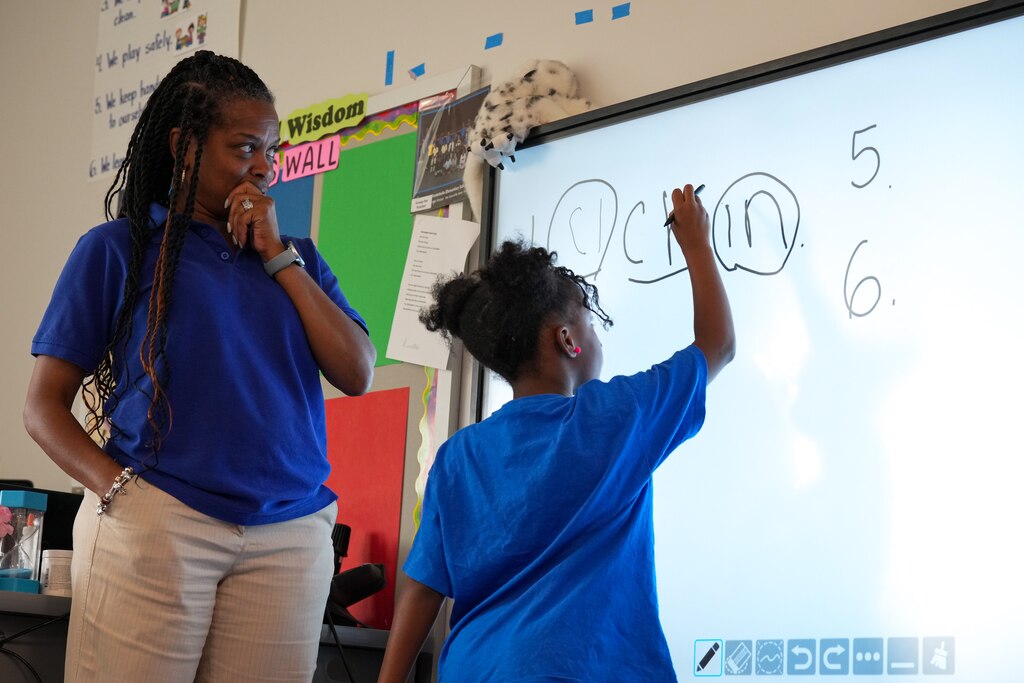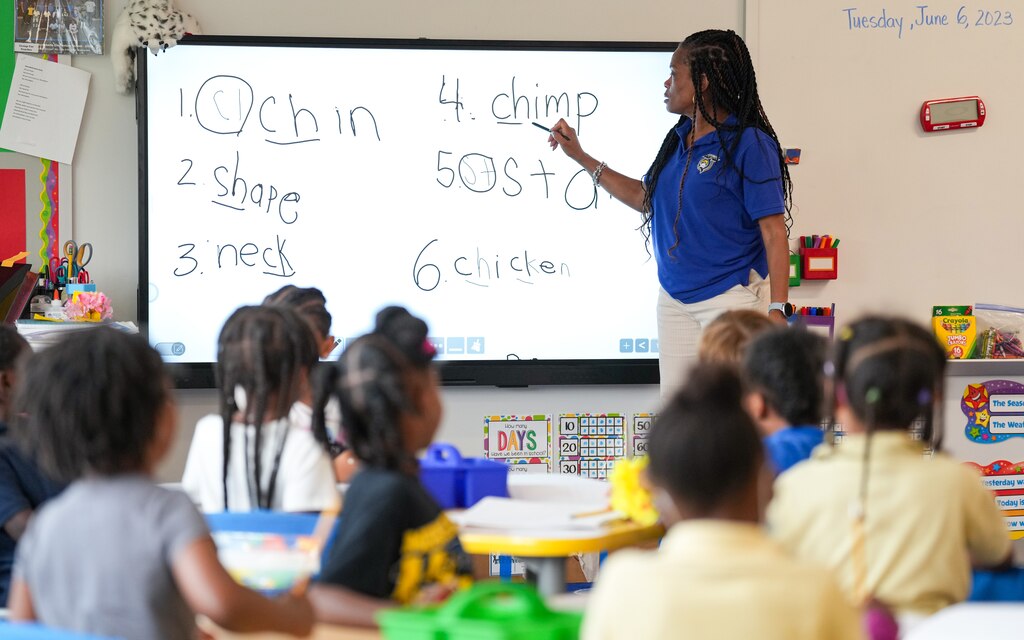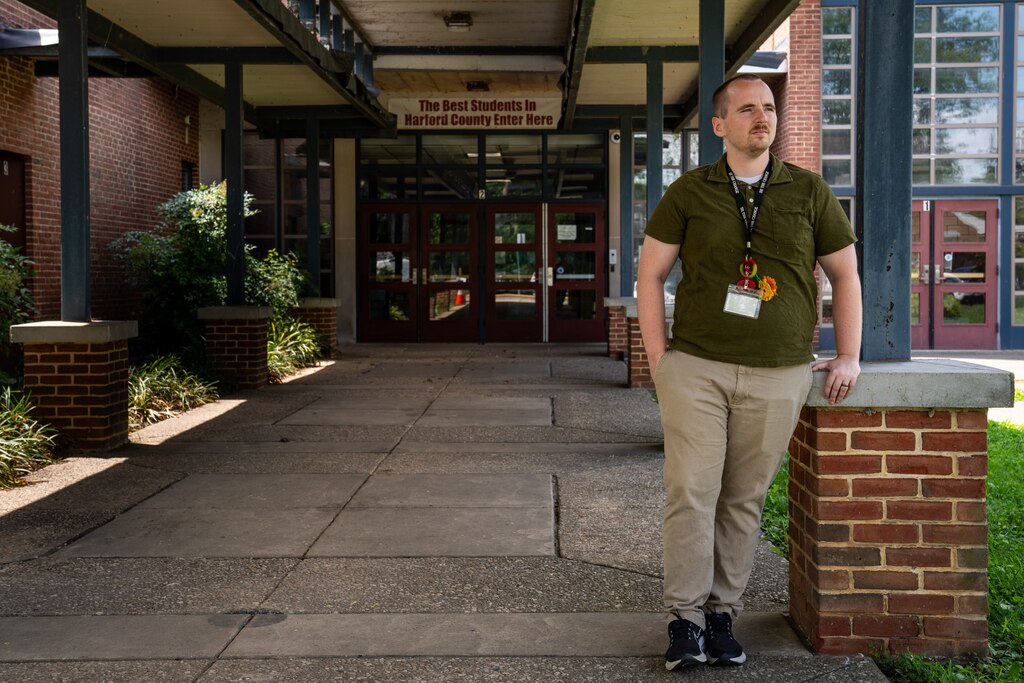On one of their last days of kindergarten, Darice Cates’ students at Montebello Elementary/Middle School attempted to write the word chicken without being shown the word or told how to spell it.
“Chop it out,” Cates said, chopping her hand through the air as she pronounced each distinct sound that made up the word. “Ch-i-ck-en,” she said.
Pencils in hand, heads bent over their papers, the students went to work: Shicken, chicken, chinckun. Not every student spelled it correctly, but they all were close, accomplishing a milestone in their journey to read. They can listen to a word and translate the sounds into letters. If Cates can get them on track to reading fluently by third grade, they are likely to succeed academically. If not, research has shown they will be four times less likely to graduate from high school.

A 28-year veteran teacher, Cates has seen education fads come and go, but she believes the Baltimore City school system has the right formula now for teaching children to read: 40 minutes a day of systematic instruction on letters and sounds, called phonics, along with a curriculum that will teach comprehension, vocabulary and knowledge of the world. It’s a method now called the science of reading, and it has prompted a nationwide reckoning about how reading is taught.
The Baltimore Banner thanks its sponsors. Become one.
That movement, backed by brain science, is finally making its way to Maryland, where educators are waking up to the fact that reading achievement has plummeted in the past decade.
The governor once bragged that the state’s public schools ranked No. 1 in the nation and signs indicating the ranking were displayed in the windows of the education department building. In 2013, Maryland’s fourth grade reading scores were second in the nation on the gold-standard National Assessment of Educational Progress. Today, the state ranks 40th.
A growing body of evidence shows the flaws of balanced literacy, a two-decade practice that taught children to memorize whole words or use context clues in a sentence to guess at new words.
But the shift to the science of reading has been slow and uneven.
While state education officials have cajoled and encouraged school systems to shift teaching habits, there’s been no law passed or state plan that requires the use of science-based reading instruction and ensures that it is faithfully implemented in every school.
The Baltimore Banner thanks its sponsors. Become one.
Baltimore was one of the state’s first school systems to embrace it, requiring schools to use a phonics-based program in 2013, adding materials and retraining teachers since then. The work appeared to pay off as the city made gains on state reading tests after years of stagnation.
Howard, Carroll and Baltimore counties have all begun the transition to curricula aligned with the science of reading, though measurable change will take years. Meanwhile, officials in neighboring Anne Arundel and Harford counties are either opposed or are behind the rest of the state.

The brain science of reading
Arguments over how to teach students to read are decades old, with educators swinging between giving children a heavy dose of phonics to just a pinch. In 1997, a Congressional panel on reading tried to put an end to the debate, declaring definitively that phonics instruction was imperative. But that met resistance, and by the early 2000s, a counter theory prevailed that children didn’t need much instruction on letters and sounds, and would learn to read naturally through exposure to lots of books and guessing words using contextual clues.
The approach, called balanced literacy, was supposed to make learning more joyous. Parents may recognize some of its hallmarks from their children’s schoolwork, like A-to-Z leveled books and “three-cueing” prompts — for example, having kids look at a picture of a horse, consider the context in the sentence and find familiarity in the letter sequence p-o-n-y to guess the word. Lucy Calkins, perhaps the greatest evangelist for balanced literacy, estimates that her Units of Study curriculum is taught in a quarter of all elementary schools.
But as brain science progressed in the past two decades, even Calkins has revised her opinion. Researchers say the evidence supports phonics-based instruction.
The Baltimore Banner thanks its sponsors. Become one.
The balanced literacy “approach does not align with how we know the brain learns to read,” said Nadine Gaab, an associate professor of education at Harvard University, who has been studying how young children learn to read using neuroimaging.

Unlike oral language, which is gained naturally as a child grows up, our brains are not wired to learn to read, Gaab said.
An area in the back of the brain, called the letter box, responds to letters or words. Viewed on an MRI of the brain, the letter box becomes active when a child sees the letter A or B, but not when a child is shown a picture with no letters. Children use four areas of the brain to learn to read and comprehend written language, and all of those areas must work in concert if the child is to become a fluent reader, Gaab said.
Donald J. Bolger, an associate professor at University of Maryland College of Education, said neuroscience shows that the brain’s entire language network is activated when people are explicitly taught the connection between letters and sounds, or the code of how to take apart words into sounds. The brain does not have the same activation when people are taught to recognize whole words, as balanced literacy instruction does.
Bolger’s research tested the theory by teaching people to read Korean. Those who were shown whole words and asked to memorize them could not use their knowledge of those words to help them read new, unfamiliar words. Those who were taught how a Korean letter corresponds to a sound learned words more slowly at first, but gradually gained speed and were able to use the sounds and letters to figure out other words they had never been shown before.
The Baltimore Banner thanks its sponsors. Become one.
In addition, those who learned to read by memorizing words started to confuse words because they might look similar, he said, adding that the confusion “is similar to the behaviors we see in struggling readers and those with reading disabilities.”
Between 30% and 40% of the population will learn to break the code of reading without a lot of explicit letter and sound instruction, he said. And explicit phonics instruction is only a piece of learning to read, Bolger and many other researchers say. Students must expand their vocabulary, comprehension and knowledge of the world to understand what they’re reading.
A ‘hodgepodge’ of teaching methods
An Education Week analysis showed that dozens of states have passed laws or implemented policies on evidence-based reading instruction since 2013. Maryland isn’t one of them.
The state’s reading law, called the Ready to Read Act, requires school districts test kindergarteners and first graders for “foundational reading skills” including knowing how to sound out words. If students are identified with reading difficulties, supplemental instruction must be provided.
But the law doesn’t say what the curriculum and supplemental instruction should be. School districts can choose, and that’s the problem, said Mohammed Choudhury, the former Maryland schools superintendent who last week moved to an advisory role.
The Baltimore Banner thanks its sponsors. Become one.
“The culture of local control has contributed to a hodgepodge of reading practices, from places where they are doing amazing things to places where they are committing malpractice when it comes to how to teach reading,” Choudhury said. “There’s no debate on how to teach reading. This is settled science.”
There are signs the state may begin to play a more active role in determining whether school districts use the science of reading.
Last week, the Maryland State Board of Education appointed an interim superintendent considered a leading authority on how to implement the science of reading.
And in August, the board tasked with implementing the Blueprint for Maryland’s Future, landmark legislation that commits millions of state and local tax dollars to improve Maryland schools, made clear it wanted districts to shift. The board decided to require school systems to use “evidence-based” plans that align with “the science of instruction,” implying that districts must use the science of reading. By June 2024, districts will be required to turn in their literacy plans.
“There’s no debate on how to teach reading. This is settled science.”
Mohammed Choudhury, the former Maryland schools superintendent
For now, the Maryland State Department of Education is encouraging local school systems to teach reading based on science by handing out a bribe: $53 million in federal pandemic relief money to retrain teachers and purchase curriculum aligned with the science of reading.
The Baltimore Banner thanks its sponsors. Become one.
Baltimore County was one of the districts who took the incentive after spending millions on balanced literacy programs. Switching to an evidence-based curriculum took nearly a year. School board members had to be convinced the change was for the better, and the piloting process lasted for months. The program was approved in May, to be implemented this school year.

So far, 22 of the state’s 24 school systems — all except Harford and Anne Arundel counties — have received the grants.
The state first turned down Anne Arundel County’s application for the funds because it deemed the instructional materials not clearly aligned with the research.
Michele Batten, assistant superintendent for curriculum and instruction, said her county is now making the shift and has reapplied for the state funding. The school system also is using some of its federal pandemic relief money to retrain literacy teachers.
“I honestly feel there is a silent epidemic of functional illiteracy. There is such incredible stigma about learning to read.”
Jo Ann Mattson, executive director of the Annapolis-based tutoring program Start The Adventure In Reading
In the meantime, some Anne Arundel parents are concerned because students are continuing to be taught using a balanced literacy approach. Only if their children are falling behind are they given more intensive phonics instruction, which seems backward, they said.
Samantha Walukonis said her second grader with dyslexia receives intensive phonics and is now reading above grade level. Her first grader, however, is an advanced reader learning the balanced literacy approach, “but his skills are not coming along as quickly as we would have expected or as quickly as hers did,” Walukonis said. She started seeing a decline in his class percentile ranking and had to break balanced literacy habits she’d witnessed at home.
Jo Ann Mattson, executive director of the Annapolis-based tutoring program Start The Adventure In Reading, said phonics is a critical piece of the work her organization does with children who often feel shame for not being able to read.
Earlier in her career as executive director of The Light House, a homeless support center, she saw how illiteracy led to incarceration, lack of employment and ultimately homelessness. She encountered Annapolis High School graduates who couldn’t read and mothers who couldn’t read the label on the baby formula or a prescription bottle.
“I honestly feel there is a silent epidemic of functional illiteracy. There is such incredible stigma about learning to read,” Mattson said.
The reading wars of Harford County
Jacob Bennett couldn’t help but cry when he looked at his 20 kindergartners during the last weeks of the 2021-2022 school year. He didn’t want to leave his Havre de Grace Elementary School students, but he couldn’t continue teaching kids how to read this way.
“I’m not going to do something that harms my children,” the 28-year-old Harford County teacher said.
Bennett and his students used to watch CBS Sunday Morning news for vocabulary lessons and hold pretend wedding ceremonies to celebrate the merging of two letters to make a sound. By the end of each school year, they were reading chapter books and most were considered advanced readers, he said.
But during the summer of 2021, he was handed a teacher guide to his school system’s newly approved reading curriculum, the balanced literacy approach Units of Study, that didn’t match the instruction he gave in his classroom. He’d usually spend five weeks teaching sounds like “sh” and “ch,” but the new curriculum, suggested teachers cover the sounds in a single lesson.
His students were progressing at a slower pace and the guidebook offered no solution.
“If a child misspells a word, they’re being a dishonest student,” Bennett recalled reading in the guide. “I don’t think there’s a student out there who misspells ‘blue’ out of malice.”

Bennett said he went “rogue” with his teaching by using downloadable programs he can access for free and started speaking out against Units of Study to staff and school board members.
He’s now a member of the County Council and works as a middle school science teacher. He’s tutored a sixth grader at lunchtime who he said went from a first-grade reading level to a third-grade level in four months.
“So many of these kids are three-plus grade levels behind,” he said. “I can only catch so many.”
Despite a contentious debate at a school board meeting this spring, Harford County approved more instructional material from Units of Study, which the curriculum review site EdReports deemed not backed by research.
Advocates for Units of Study and other balanced literacy curricula say they aren’t against a small amount of phonics, but the emphasis should be on building a love for reading. That means giving kids a wide variety of books, for example, and not bogging them down with too much instruction.
Units of Study features a strategy called “guess the covered word” and encourages using pictures to predict words. Harford’s supervisor of reading, Kristine Scarry, said teachers have been instructed not to use the strategy “since it is not supported or aligned to the science of reading” and give 40 minutes of phonics instruction a day, double the curriculum’s suggested time.
“We want our students to look at every letter in the words, apply phonics knowledge and sound words out,” she said.
Harford is among a number of Maryland school districts supplementing their core reading curricula with a laundry list of “supplemental” materials — other methods of instruction from which teachers can pick and choose. That should raise red flags, according to experts at EdReports. Supplementing can be necessary, they said, but districts should know where the gaps are in the core curriculum before deciding on additional instruction.
“What seems like could be happening is that you’re supplementing your supplement,” said Jamilah Hicks, EdReports’s director of English language arts.
Harford, for example, uses supplemental materials by both Wilson Fundations and Heggerty. Fundations covers foundational reading skills including phonological awareness. Heggerty addresses only phonological awareness. The two programs are doing the same job.
Hicks also wondered about professional development and whether teachers have time to learn how and when to use all these programs. “Teachers need someone, or a committee, to clearly outline the components of those programs that will be used and those that will not be used,” she said.
“We are graduating kids who don’t know how to read.”
Lori Sappington, a Harford County parent, teacher and literacy podcast host
Scarry said Harford’s professional development for teachers includes tenets of the science of reading and that they were trained in a phonemic awareness program. The system spent “quite a bit of money” on decodable books so students can practice phonics.
She said phonics instruction was one reason the county saw a rise in the proportion of students passing state reading tests this year; data shows reading scores increased by 5.8 percentage points from 2019 to 2023. But the kindergartners who learned to read using Units of Study will not be tested by the state until 2025 when they are in third grade.
Still, some teachers and parents are pushing back against the county’s determination to continue using Units of Study. In chatter at school bus stops and on parent Facebook pages, parents are now questioning why their children can’t read.
“We are graduating kids who don’t know how to read,” said Lori Sappington, a Harford County parent, teacher and literacy podcast host. “It took me until 12 years into my teaching career to begin this journey to understand reading science. Once you learn it, you can’t unlearn it. It is so powerful. We have the answer to this problem and now we have to find ways to get the solution to our students.”
In response to the pushback, Harford County started piloting a science of reading curriculum this school year in 11 of its 33 elementary schools. The pilot will last six years.
A new era for literacy?
How far Maryland will go in mandating changes in literacy could well be determined in the next year. Last week, the woman who led Mississippi’s literacy overhaul was appointed Maryland’s interim superintendent of schools.
Carey Wright helped guide Mississippi from close to the bottom on the National Assessment of Educational Progress, known as the Nation’s Report Card, in fourth grade reading in the early 2010s to above the national average. Its reading scores are now better than Maryland’s.
Mississippi’s science of reading law, passed in 2013, spells out how it was done. Third graders who score poorly on the state test cannot move on to fourth grade, and educators teaching kindergarten through third grade have to be trained in science of reading instruction.
“I always say that a literacy law is an equity law,” said Kymyona Burk, a former literacy director for Mississippi who was on the frontlines of the implementation process. “In some cases, when there is not a law, then these things are hit or miss. They may be happening in some areas, but in other areas they’re not. What we want to ensure is that there is policy to hold people accountable.”
Burk said literacy coaches were put in the state’s lowest-performing schools, the state’s education department was restructured to add an office of intervention services, and multiple parent nights were scheduled to help them understand the law.

As a fellow at the nonprofit ExcelinEd, Burk helps other states implement their literacy laws. One trend she noticed is that the law often only applies to kindergarten and first grade, as it does in Maryland, when it should be expanded to second and third. It should also include high quality instructional materials aligned to the science of reading, literacy coaches, evaluations for dyslexia, funding and training for teachers.
Universities who train teachers will have to make the switch, too.
Simone Gibson, an associate professor of teacher education and professional development at Morgan State University, said graduates came back to her and said the reading instruction approach they were taught in college wasn’t working for their young students.
“We had so many kids who came back who said, we love this institution, but we are not trained to meet the needs of our kids. That’s hard to hear, but it really challenged us to go back to the drawing board,” Gibson said. “We traditionally have approached a more balanced literacy way of training our candidates, and it just was not working.”
Gibson revamped her curriculum and began a science-based, strategic approach that gives teacher candidates techniques rather than the idea that if their students know their ABCs they will learn to read naturally. “What they learn is that reading is really hard,” Gibson said.
In Baltimore City, where some of Gibson’s students teach, the changes are beginning to pay off. Reading test scores on the Maryland English test have risen every year for the past six years. In 2016, 14% of elementary school students passed the Maryland Comprehensive Assessment Program, compared to 22% in 2023. For the last two years, the city’s increases have outpaced the statewide average increase.
In some of its elementary schools, the city has begun 30-minute-a-day small group tutoring for city children who their teachers feel aren’t catching on to phonics. At Montebello, teachers assistants are confident they can turn nearly every child into a beginning reader. Their work is backed up by data that shows students in grades kindergarten through second grade who were significantly behind made progress in the city’s tutoring.
Wright, who starts work later this month, said she would not be “adverse” to a science of reading law in Maryland. “I’ve seen it work. When you’ve got decades of research that supports that this works in teaching children — all children — how to read, that’s significant.”
Teachers are embracing the science of reading, Wright said, once they are trained. “Once you experience it, and once you really see your kids becoming readers, it’s like the proof is right before your eyes...”
“The science of reading works, and we’ve got a lot of work to do.”


Comments
Welcome to The Banner's subscriber-only commenting community. Please review our community guidelines.